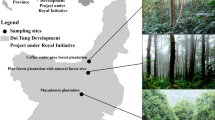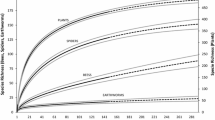Abstract
Coffee agroforestry is a conservation strategy that has shown promise to support the diversity of bird, bat, and insect communities, but few studies have focused on non-volant mammals in coffee farms. We assessed mammal diversity within coffee agroforestry systems in Kodagu, India and investigated the impacts of the non-native shade tree species, Grevillea robusta, on mammal diversity. Twenty farms, with varying amounts of G. robusta planted within the coffee farm, were sampled throughout three rainfall zones during the 4-month study period. We captured six species of small mammals, with indirect methods yielding an additional five species, totaling 11 mammal species. Contrary to current ecological thought, we found that increased amounts of G. robusta did not have a negative impact on either abundance or richness of mammals. Small mammal abundances were higher at farms with greater amounts of herbaceous ground cover and larger, mature shade trees, while small mammal species richness was found to increase with an increase in tree species richness as well as greater amounts of herbaceous ground cover. Additionally, small mammal abundance was higher at coffee farms closer to forested areas. Based on these findings, we suggest the maintenance or cultivation of shade tree richness, mature shade trees, and herbaceous ground cover within coffee farms and preservation of forested areas within the landscape to enhance coffee agroforestry habitat for non-volant mammals. We hope that these habitat requirements will be incorporated into conservation strategies for the promotion of biodiversity within coffee agroforestry systems.


Similar content being viewed by others
References
Anand MO, Krishnaswamy J, Das A (2008) Proximity of forests drives bird conservation value of coffee plantations: implications for certification. Ecol Appl 18:1754–1763
Bali A, Kumar A, Krishnaswamy J (2007) The mammalian communities in coffee plantations around a protected area in the Western Ghats, India. Biol Cons 139:93–102
Bhagwat SA, Kushalappa CG, Williams PH, Brown ND (2005) A landscape approach to biodiversity conservation of sacred groves in the Western Ghats of India. Conserv Biol 19(6):1853–1862
Bhagwat SA, Willis KJ, Birks HJB, Whittaker RJ (2008) Agroforestry: a refuge for tropical biodiversity? Trends Ecol Evol 23:261–267
Caudill SA (2013) Assessment of mammal biodiversity in coffee-dominated landscapes of India and Costa Rica. Dissertation, University of Rhode Island
Chandrasekar-Rao A, Sunquist ME (1996) Ecology of small mammals in tropical forest habitats of Southern India. J Trop Ecol 12:561–571
Clough Y, Dwi Putra D, Pitopang R, Tscharntke T (2009) Local and landscape factors determine functional bird diversity in Indonesian cacao agroforestry. Biol Conserv 142:1032–1041
Cruz-Lara LC, Lorenzo C, Soto L, Naranjo E, Ramirez Marical N (2004) Diversidad de mamíferos en cafetales y selva mediana de las cañadas de la Selva Lacandona, Chiapas, México. Acta Zoo Mex 20:63–81
Das A, Krishnaswamy J, Bawa KS, Kiran MC, Srinivas V, Kumar NS, Karanth KU (2006) Prioritisation of conservation areas in the Western Ghats, India. Biol Cons 133:16–31
DeClerck FAJ, Chazdon R, Holl KD, Milder JC, Finegan B, Martinez-Salinas A, Imbach P, Canet L, Ramos Z (2010) Biodiversity conservation in human-modified landscapes of Mesoamerica: past, present and future. Biol Cons 143:2301–2313
Ecobichon DJ (2001) Pesticide use in developing countries. Toxicology 160(1–3):27–33
French Institute of Pondicherry (2012a) Managing Biodiversity in Mountain Landscapes. Linking forestry, agroforestry and livelihoods in the Western Ghats. Pondicherry, India. http://www.ifpindia.org/managing-biodiversity-in-mountain-landscapes.html. Accessed 4 Dec 2012
French Institute of Pondicherry (2012b) Changes in rainfall pattern over the last decades in the coffee agroforestry landscape of Kodagu, South-Western India. Pondicherry, India. http://www.ifpindia.org/managing-biodiversity-in-mountain-landscapes.html. Accessed 4 Dec 2012
Gallina S, Mandujano S, Gonzalez-Romero A (1996) Conservation of mammalian biodiversity in coffee plantations of Central Veracruz, Mexico. Agroforest Syst 33:13–27
Garcia C, Pascal JP (2006) Sacred forests of Kodagu: ecological value and social role. In: Cederlöf G, Sivaramakrishnan K (eds) Ecological nationalisms: nature, livelihoods, and identities in South Asia. University of Washington Press, Seattle and London, pp 199–229
Garcia CA, Bhagwat SA, Ghazoul J, Nath CD, Nanaya KM, Kushalappa CG, Raghuramulu YR, Nasi Vaast P (2009) Biodiversity conservation in agricultural landscapes: challenges and opportunities of coffee agroforests in the Western Ghats, India. Conserv Biol 24:479–488
Gordon C, Manson R, Sundberg J, Cruz-Angón A (2007) Biodiversity, profitability, and vegetation structure in a Mexican coffee agroecosystem. Agric Ecosyst Environ 11:256–266
Harvey CA, González Villalobos JA (2007) Agroforestry systems conserve species-rich but modified assemblages of tropical birds and bats. Biodivers Conserv 16:2257–2292
Husband TP, Abedon DH, Donelan E, Paton PWC (2009) Do coffee-dominated landscapes support mammal biodiversity? Costa Rica 2005–2008. Second World Agroforestry Congress, Nairobi
International Coffee Organization (2012) Coffee market report. ICO, London
IUCN (2013) IUCN Red List of Threatened Species. Version 2013.1. www.iucnredlist.org. Accessed 17 Nov 2013
Klinger R (2006) The interaction of disturbances and small mammal community dynamics in a lowland forest in Belize. J Anim Ecol 75:1227–1238
Lambert TD, Malcolm JR, Zimmerman BL (2006) Amazonian small mammal abundances in relation to habitat structure and resource abundance. J Mammal 87:766–776
Luck GW, Daily GC (2003) Tropical countryside bird assemblages: richness, composition, foraging differ by landscape context. Ecol Appl 13:235–247
Marie-Vivien D, Garcia C, Vaast P (2013) Trademarks, geographical indications and environmental labeling to promote biodiversity: the case of agroforestry coffee in India. Dev Policy Rev (accepted)
Menon V (2009) Mammals of India. Princeton University Press, Princeton
Molur S, Nameer PO (2008) Funambulus tristriatus. In: IUCN 2013. IUCN Red List of Threatened Species. Version 2013.1. www.iucnredlist.org. Accessed 17 Nov 2013
Molur S, Singh M (2009) Non-volant small mammals of the Western Ghats of Coorg district, Southern India. J Threatened Taxa 1:589–608
Murie O, Elbroch M (2005) A field guide to animal tracks. Peterson Field Guide Series., 3rd edn. Houghton Mifflin Company, Boston
Perfecto I, Vandermeer J (2008) Biodiversity conservation in tropical agroecosystems: a new conservation paradigm. Ann NY Acad Sci 1134:173–200
Perfecto I, Mas A, Dietsch T, Vendermeer J (2003) Conservation of biodiversity in coffee agroecosystems: a tri-taxa comparison in Southern Mexico. Biodivers Conserv 12:1239–1252
Perfecto I, Vandermeer J, Mas A, Pinto LS (2005) Biodiversity, yield, and shade coffee certification. Ecol Econ 54:435–446
Philpott SM, Bichier P (2012) Effects of shade tree removal on birds in coffee agroecosystems in Chiapas, Mexico. Agric Ecosyst Environ 149:171–180
Philpott SM, Bichier P, Rice R, Greenberg R (2007) Field-testing ecological and economic benefits of coffee certification programs. Conserv Biol 21:975–985
Philpott SM, Arendt WJ, Armbrecht I, Bichier P, Diestch TV, Gordon C, Greenberg R, Perfecto I, Reynoso-Santos R, Soto-Pinto L, Tejeda-Cruz C, Williams-Linera G, Valenzuela J, Zolotoff JM (2008) Biodiversity loss in Latin American coffee landscapes: review of the evidence on ants, birds, and trees. Conserv Biol 22:1093–1105
Rice R (2010) The ecological benefits of shade-grown coffee: the case for going Bird Friendly®. Smithsonian Migratory Bird Center - National Zoological Park, Washington D.C. http://nationalzoo.si.edu/scbi/migratorybirds/coffee/bird_friendly/Eco-Report.pdf. Accessed 4 Dec 2012
Ricketts TH, Daily GC, Ehrlich PR, Fay JP (2001) Countryside biogeography of months in fragmented a landscape: biodiversity in native and agricultural habitats. Conserv Biol 15:378–388
Schroth G, Harvey CA (2007) Biodiversity conservation in cocoa production landscapes: an overview. Biodivers Conserv 16:2237–2244
Shanker K, Sukumar R (1998) Community structure and demography of small-mammal populations in insular montane forests in Southern India. Oecologia 116:243–251
Smithsonian Migratory Bird Center (2012) National Zoological Park, Washington D.C. http://nationalzoo.si.edu/scbi/migratorybirds/coffee/roaster.cfm. Accessed 4 Dec 2012
Smithsonian Migratory Bird Center. Shade management criteria for “Bird Friendly” Coffee. National Zoological Park, Washington D.C. http://nationalzoo.si.edu/scbi/migratorybirds/coffee/criteria.cfm. Accessed 11 Oct 2013
SAS Software (2010) SAS Institute, Cary, North Carolina
Sustainable Agriculture Network (2010) Sustainable Agriculture Standard. Sustainable Agriculture Network, San Jose, Costa Rica. http://sanstandards.org/sitio/subsections/display/9. Accessed 4 Dec 2012
Sustainable Agriculture Network (2012) Certified Farms and Operations. Sustainable Agriculture Network, San Jose, Costa Rica. http://sanstandards.org/sitio/subsections/display/16. Accessed 4 Dec 2012
Taylor DA (2007) Certified coffee: does the premium pay off? Environ Health Perspect 115:A456–A459
UTZ (2012) UTZ Certified Coffee. Amsterdam, Netherlands. www.utzcertified.org. Accessed 5 Dec 2012
Weist M, Tscharntke T, Sinaga MH, Maryanto I, Clough Y (2010) Effect of distance to forest and habitat characteristics on endemic versus introduced rat species in agroforest landscapes of Central Sulawesi, Indonesia. Mamm Biol 75(6):567–571
Williams-Guillén K, Perfecto I (2010) Effects of agricultural intensification on the assemblage of leaf-nosed bats (Phyllostomidae) in a coffee landscape in Chiapas, Mexico. Biotropica 42:605–613
Wilson DE, Reeder DM (2005) Mammal species of the world. A taxonomic and geographic reference. Johns Hopkins University Press, Baltimore
Acknowledgments
We would like to thank Dr. C. Kushalappa for his assistance and support throughout the mammal study and Sanjay and Payal Molur for their insight and guidance. We would also like to thank Kate Vaast for her advice and assistance and S. Meederira for support with the field logistics. We are grateful to Dr. Nancy Karraker and the anonymous reviewers for providing valuable comments and suggestions to strengthen this manuscript and Dr. Liliana Gonzalez for her assistance with the analysis. This study would not have been possible without the countless hours of hard work from the CAFNET mammal field team—Research Associates: Asha Tantry, Kiran Kumar, N. K. Chinnappa, Poornika Rani; field assistants: Machaiah, Nijil, Pratap, Sunil Subbaiah, Sharath; and drivers: Maduna and Sunil Subbaiah. In addition, we would like to thank the many farmers and agriculturalist for their participation in the study and for allowing us access to their coffee farms. We would also like to thank the United States Department of Agriculture International Science and Education Program for providing us with the funding to conduct this research.
Author information
Authors and Affiliations
Corresponding author
Rights and permissions
About this article
Cite this article
Caudill, S.A., Vaast, P. & Husband, T.P. Assessment of small mammal diversity in coffee agroforestry in the Western Ghats, India. Agroforest Syst 88, 173–186 (2014). https://doi.org/10.1007/s10457-013-9664-3
Received:
Accepted:
Published:
Issue Date:
DOI: https://doi.org/10.1007/s10457-013-9664-3




